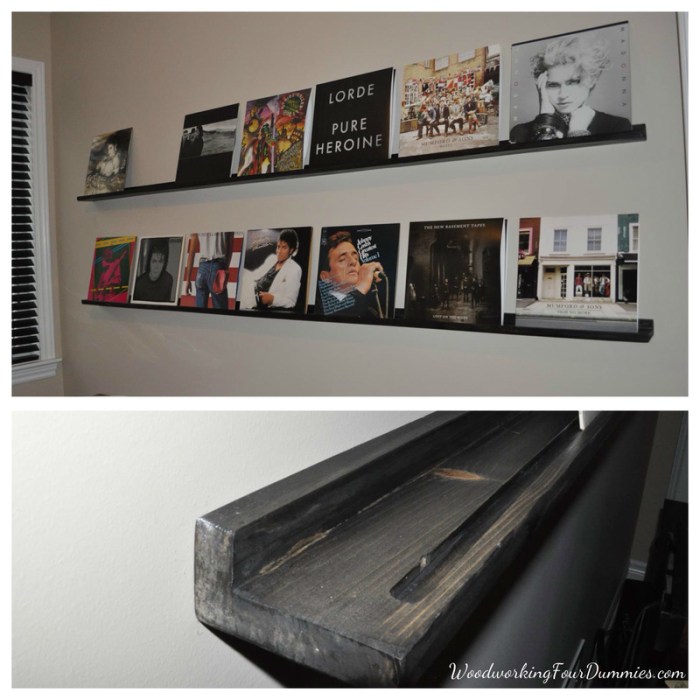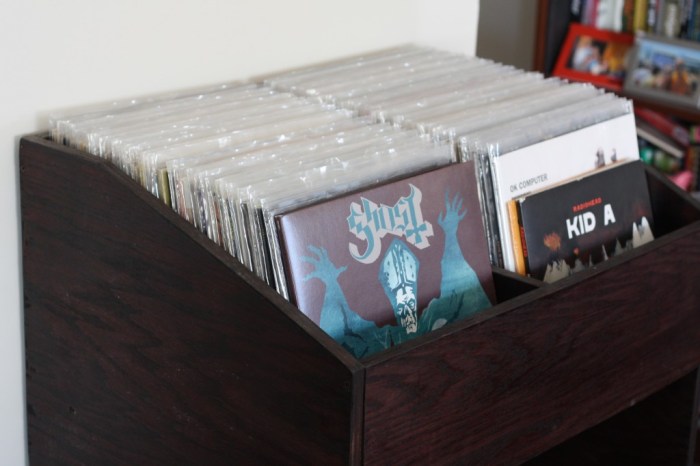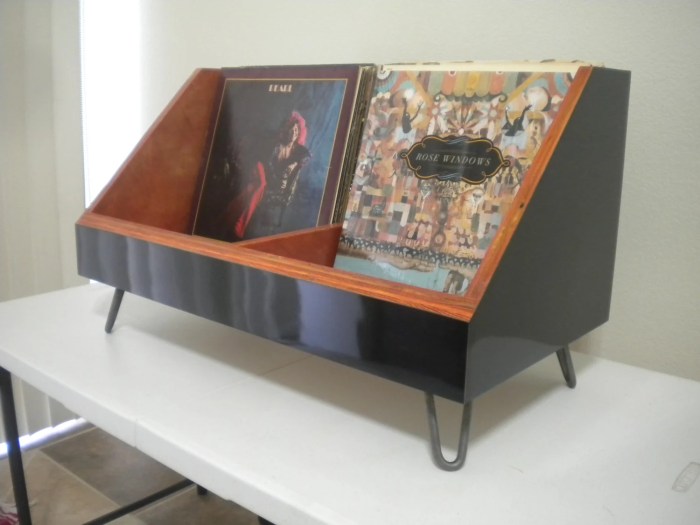DIY Record Shelf: Build Your Own Vinyl Haven. The resurgence of vinyl records has sparked a creative wave, inspiring countless music lovers to build custom storage solutions for their prized collections. Crafting a DIY record shelf not only saves money but also allows for personalized design and a sense of accomplishment.
This guide delves into the process of constructing a DIY record shelf, from initial planning and design to the final assembly and finishing touches. We’ll cover essential tools and materials, step-by-step instructions, customization options, and safety precautions to ensure a successful project. Whether you’re a seasoned DIY enthusiast or a novice looking to embark on your first woodworking adventure, this comprehensive guide will equip you with the knowledge and inspiration to build a functional and stylish record shelf that reflects your unique taste.
Building Your Own Record Shelf
In today’s world, DIY projects and vinyl record collecting are experiencing a resurgence in popularity. People are drawn to the satisfaction of creating something with their own hands, and the warm, analog sound of vinyl records has captivated a new generation of music lovers. Building a DIY record shelf offers a unique opportunity to combine these two passions, allowing you to craft a functional and stylish piece of furniture that reflects your personal taste.
Benefits of a DIY Record Shelf
Building a DIY record shelf provides several advantages, including:
- Cost Savings: Purchasing a pre-made record shelf can be expensive. By building your own, you can save a significant amount of money. You have complete control over the materials and design, allowing you to choose affordable options without compromising on quality.
- Customization: A DIY record shelf allows you to tailor the design to your specific needs and preferences. You can choose the size, shape, materials, and finish to perfectly complement your existing decor and record collection.
- Sense of Accomplishment: Completing a DIY project like a record shelf provides a sense of pride and accomplishment. You can showcase your craftsmanship and create a unique piece of furniture that you can enjoy for years to come.
Construction Process

Now that you have your materials ready, it’s time to bring your record shelf to life! The construction process involves a few key steps, including cutting, drilling, sanding, and finishing.
Cutting the Wood
Before you start cutting, make sure you have a clear understanding of the dimensions of your record shelf and the wood you’re using. Using a tape measure, mark the wood precisely where you need to cut it. This will help ensure your shelf comes out to the correct size.
- For precise cuts, use a table saw. It’s best for cutting straight lines, ensuring your shelf pieces are even and consistent.
- If you don’t have a table saw, a circular saw is another option. However, it can be more challenging to get perfectly straight cuts.
- For smaller cuts, a hand saw or jigsaw can be used.
Drilling and Assembling
Drilling pilot holes before assembling your shelf is essential. This prevents the wood from splitting when you screw it together. Pilot holes should be slightly smaller than the screw diameter.
- Use a drill bit that’s appropriate for the type of wood you’re using.
- When drilling, use a drill press for greater accuracy.
- After drilling, use a countersinking bit to create a recess for the screw head. This will help ensure the screw head sits flush with the surface of the wood.
Sanding and Finishing
Once your shelf is assembled, it’s time to sand it down to create a smooth finish. Start with a coarse-grit sandpaper to remove any rough edges or imperfections. Then, gradually move to a finer-grit sandpaper for a smoother finish.
- For a natural look, use a wood stain or oil finish.
- If you want a more durable finish, use a polyurethane or varnish.
- Apply the finish in thin coats, allowing each coat to dry completely before applying the next.
Creating Sturdy Joints, Diy record shelf
To create sturdy joints, use wood glue and screws. This will ensure your shelf is strong and durable. When gluing, apply a thin layer of glue to the surfaces you’re joining. Then, clamp the pieces together and allow the glue to dry completely.
Ensuring Level and Stability
Before you put your record collection on the shelf, make sure it’s level and stable. Use a level to ensure the shelf is perfectly horizontal. If it’s not, adjust the legs or feet until it is. You can also use shims to help level the shelf.
Record Storage and Display: Diy Record Shelf

After building your record shelf, the next step is to decide how you want to store and display your vinyl collection. There are many different ways to do this, and the best method for you will depend on your personal preferences, the size of your collection, and the space you have available.
Vertical Storage
Vertical storage is the most common method for storing records. It involves storing records upright, with the spines facing outward. This method is ideal for maximizing space and making it easy to browse your collection. Vertical storage can be achieved using a variety of methods, including:
- Record shelves: These are specifically designed for storing records vertically, and they typically have adjustable shelves to accommodate different record sizes.
- Bookcases: Bookcases can also be used to store records vertically, as long as the shelves are deep enough to accommodate the records.
- Wall-mounted record shelves: These are a great way to save space and add a decorative element to your room.
Horizontal Storage
Horizontal storage involves storing records flat, with the covers facing upward. This method is less common than vertical storage, but it can be a good option for displaying your favorite records or for protecting records from dust and damage. Horizontal storage can be achieved using a variety of methods, including:
- Record crates: These are sturdy boxes that are designed to hold records flat. They are a good option for storing records that you don’t use often.
- Record racks: These are metal or wooden racks that are designed to hold records flat. They are a good option for displaying records in a stylish way.
- Wall-mounted record holders: These are similar to record racks, but they are mounted on the wall. They are a good option for saving space and adding a decorative element to your room.
Organizing Your Records
Once you’ve decided on a storage method, you’ll need to decide how to organize your records. There are many different ways to do this, and the best method for you will depend on your personal preferences. Some popular methods include:
- By genre: This is a simple and straightforward way to organize your records. You can create separate sections for different genres, such as rock, pop, jazz, classical, etc.
- By artist: This is a good option if you have a lot of records by the same artist. You can create separate sections for each artist, and then organize the records within each section by release date or album title.
- By release date: This is a good option if you’re interested in collecting records from a particular era. You can create separate sections for different years or decades.
- By album title: This is a good option if you want to be able to quickly find a specific record. You can organize your records alphabetically by album title.
Budget Considerations

Building your own record shelf can be a cost-effective way to create a custom storage solution for your vinyl collection. While the overall cost will vary depending on the size, design, and materials used, it’s generally cheaper than buying a pre-made shelf.
Estimating Costs
Here’s a breakdown of the estimated costs for materials and tools:
- Wood: $20 – $100 (depending on the type of wood, size, and quantity)
- Hardware: $10 – $30 (including screws, brackets, and hinges)
- Tools: $20 – $50 (if you don’t already own basic tools like a saw, drill, and screwdriver)
- Finishing: $10 – $30 (optional, for stain, paint, or sealant)
You can expect to spend anywhere from $50 to $200 for a DIY record shelf, depending on the complexity and quality of materials.
Finding Affordable Materials
- Check local lumber yards: They often have discounted wood scraps or remnants that you can use for your project.
- Shop at secondhand stores: You may find salvaged wood or pre-made shelves that you can repurpose.
- Consider using plywood: It’s a cost-effective alternative to solid wood and can be just as sturdy.
- Use reclaimed materials: Think outside the box and use old pallets, crates, or furniture pieces to create a unique and eco-friendly shelf.
Maximizing Value
- Plan your design carefully: Avoid unnecessary waste by creating a detailed plan before you start cutting wood.
- Use simple designs: A straightforward design will require less material and time to build.
- Shop around for the best prices: Compare prices at different stores and online retailers.
- Consider DIY tools: If you’re only building a single shelf, you may be able to borrow or rent tools instead of buying them.
Building a DIY record shelf is an enriching experience that combines creativity, practical skills, and a love for music. With careful planning, attention to detail, and a dash of personal flair, you can create a custom storage solution that not only safeguards your vinyl collection but also enhances your listening space. So, gather your tools, select your materials, and embark on this rewarding DIY journey, transforming your passion for music into a tangible masterpiece.
Building a DIY record shelf can be a fun weekend project, especially if you’re looking to add a unique touch to your home. While you’re getting crafty, you might also consider building a DIY mouse trap bucket, like the one found here , to keep your home pest-free. Once your record shelf is complete, you can finally organize your vinyl collection and enjoy the sound of your favorite tunes without any unwanted distractions.
